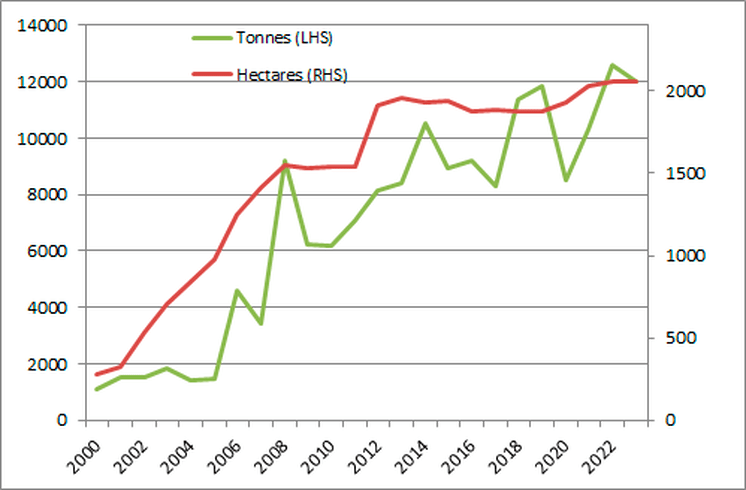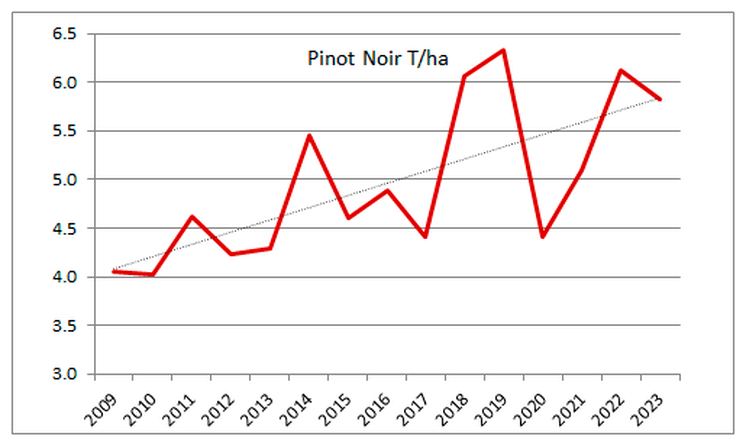
Recent reports on New Zealand’s annual vintage statistics have made waves, highlighting the wine industry’s remarkable success. The total value of New Zealand’s wine exports (year to May 2023) has surged by 25% compared to the previous year, reaching an impressive 2.4 billion. With this surge, wine has now become New Zealand’s fifth-largest export, attributing much of its latest triumph to a record-breaking harvest last year.
While these headline figures paint a promising picture for the industry, this article delves deeper into the local landscape to unveil the intriguing developments taking place at the heart of Central Otago’s grape production. Over the past decade, this region has seen growth in grape production, despite minimal new vineyard plantings. The situation reveals a significant shift in the dynamics of Central Otago’s renowned wine industry.
Pinot Noir, which consistently accounts for 78% of total grape production, is estimated to occupy approximately 1,600 hectares of the planted area.
The two charts below use data sourced from NZ Winegrowers annual vintage statistics and the annual report. The first chart shows annual grape production (LHS axis) and total hectares in vines (RHS axis) since 2000. The second chart is Pinot Noir only and shows annual production (tonnes) per hectare from 2009 to 2023.


A glance at the production and vine area trends since 2009 reveals a remarkable increase in Pinot Noir yield per hectare. This rise of over 30% in production per hectare over the last ten years cannot be attributed to seasonal or climatic patterns alone.
We are seeing the outcome of a structural change in the local industry.
The story of this transformation traces back to the late 1990s when Central Otago gained recognition as one of the few regions capable of producing world-class Pinot Noir. This led to a surge in new vineyard plantings, propelling the total area from 135 hectares in 1997 to 1,415 hectares in 2007. Since 2012, the planted area (1,917 hectares) has seen minimal change, with 2,055 hectares recorded in 2022.
Production increased rapidly, particularly in 2008 when Pinot Noir output doubled (see chart). The sudden increase in production created a surplus of wine which many new wineries did not have established markets for. The increase in production across New Zealand in 2008 coincided with the Global Financial Crisis. The situation prompted wineries to reassess their business plans. Notably, some wineries in other regions, primarily Marlborough, recognized an opportunity to produce Central Otago Pinot Noir alongside their Marlborough Sauvignon Blanc. As a result, the shipping of grapes from Central Otago to Marlborough to produce Central Otago Pinot Noir has steadily increased since 2008.
Presently, a substantial portion of the Central Otago Pinot Noir harvest is used for lower-priced wines made in Marlborough or for lower-priced second labels for Central Otago-based wineries. However, locally owned wineries in Central Otago continue to produce high-quality Pinot Noir that rivals the best in the world while maintaining competitive prices.
In recent years, international brands and wealthy individuals have started investing in local vineyards, recognizing Central Otago’s long-term potential as a world-class Pinot Noir producer.
Companies’ motivations for increasing production vary, with some growers prioritizing higher yields at lower costs. However, overcropping risks compromising wine quality, as well as increasing the likelihood of plant diseases.
Viticulturists have been adjusting management practices and crop levels as vineyards mature and insights into site capabilities improve. While increasing production can be achieved through various methods, high yields alone do not guarantee the production of world-class Pinot Noir.
Central Otago’s reputation as a producer of world-class Pinot Noir continues to solidify, but some companies’ practices risk jeopardizing the established reputation forged by early producers. To label a wine as Central Otago Pinot Noir, it must contain at least 85% Central Otago grapes, with the possibility of incorporating up to 15% Marlborough Pinot Noir without disclosure.
While producing Central Otago Pinot Noir from lower-cost grapes may seem economically favourable in the short term, maintaining genuine quality is crucial for long-term success. It is vital to recognize that an excessive number of producers creating lower-quality Pinot Noir could diminish the allure of the Central Otago Pinot Noir brand.
As the range of wines labelled as Central Otago Pinot Noir expands, it becomes essential for consumers to follow reputable independent wine reviewers who rank wines and wineries based on consistent high quality. The responsibility lies with all wine producers to uphold high standards in growing and producing Central Otago Pinot Noir to maintain its reputation as a world-class wine.
In this expanding landscape, producer brand names are increasingly crucial indicators of the wine’s quality and authenticity.
